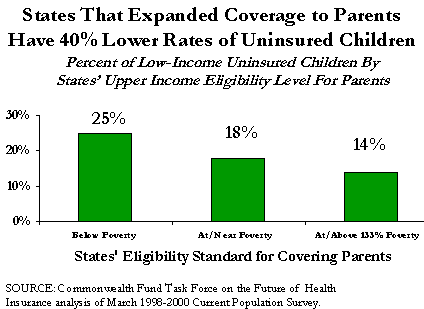A new report from The Commonwealth Fund suggests that extending insurance to parents may not only decrease the number of uninsured Americans but may be the best way to cover more uninsured children. The report, Health Insurance: A Family Affair, by Jeanne M. Lambrew of George Washington University, reveals that in states that have expanded Medicaid and State Children's Health Insurance Program (CHIP) coverage to parents as well as children, uninsured rates for eligible children are far lower than in states that have not expanded coverage to parents.
"The failure of states to insure parents-and entire families-at least partly explains the slow growth of insurance coverage for children in some states and the persistence of high uninsured rates," said Cathy Schoen, executive director of The Commonwealth Fund Task Force on the Future of Health Insurance. "This report suggests that proposals to encourage states to expand health insurance to low-income parents could benefit not only these parents but their children, too."
 Currently, state Medicaid and CHIP income eligibility rates for parents are shockingly low-less than 50 percent of the federal poverty level in some states. This means that many low-income, working parents have too much income to qualify for state coverage but too little income to afford private insurance. Extending Medicaid or CHIP to parents would not only provide them with an important coverage option, it would remove the fear of losing affordable coverage for those leaving welfare for work.
Here are some key findings from the report:
Currently, state Medicaid and CHIP income eligibility rates for parents are shockingly low-less than 50 percent of the federal poverty level in some states. This means that many low-income, working parents have too much income to qualify for state coverage but too little income to afford private insurance. Extending Medicaid or CHIP to parents would not only provide them with an important coverage option, it would remove the fear of losing affordable coverage for those leaving welfare for work.
Here are some key findings from the report:
- Over 9 million parents are uninsured. Nearly two-thirds, or 6.2 million, of these parents have incomes below 200 percent of the poverty level ($36,000 for a family of four). Uninsured parents and children comprise half of all low-income uninsured.
- Uninsured rates are increasing for parents while decreasing for children. The proportion of low-income parents without health insurance rose from 31 to 33 percent from 1996 to 1999, but fell for children. There were 1 million fewer uninsured children in 1999 than 1998.
- Uninsured rates for low-income parents vary widely across states. Arizona and New Mexico have the highest rate-47 percent-while Hawaii has the lowest (11 percent). The rate of uninsured, low-income parents in states that expanded public coverage to parents with income above poverty was more than 40 percent lower than that in states without such coverage expansions.
- Low-income children with insured parents are nearly twice as likely to have health coverage as children with uninsured parents. Around 90 percent of low-income children who have insured parents are themselves insured. In contrast, less than half (48%) of children with an uninsured parent have health coverage.
- States that extended coverage eligibility to parents above the poverty level have nearly half the uninsured child rate of states with low eligibility limits. About 25 percent of low-income children were uninsured in states that had not expanded coverage for parents in 1998, compared with an average 14 percent uninsured child rate in states with parent coverage expansions.


